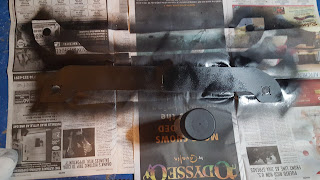Hi Erik,
Thank you for your patience! We have finished our review and have reached a decision. Congratulations! Your costume has been approved and I've moved your application into the next phase. Welcome to the 501st Legion!
There are a couple of suggestions on changes to your armor to make it fit a little better.
1) Shorten the straps on your shoulder bells, this will reduce the black undersuit from showing through on the shoulders
2) Bring you thigh armor up higher - you may need to simply shorten the straps on this as well
It's official - I've been approved to be a member of the 501st!
Approved - but with caveats.
However, I found the email slightly bittersweet as it confirms something that I've known was probably true - I trimmed my thighs too short.
The shoulder bells will be an easy fix as I just need to fasten the H&L straps farther into the bell - that's just a donning issue. The thighs, though, they don't go up any higher, and as you can see in my photo above, I'm showing way too much black on my hips. Sure, the thighs are comfortable to walk in, but they probably won't fly for EIB or Centurion approval.
I've honestly been thinking about this since I sent my approval in, and it's been one of the few things I've been fretting about in regards to the armor and being approved at all. So, I've decided to revert the thighs to (close to) original condition.
It won't be easy, but it won't be terribly hard either, with my knowledge of shimming thanks to my thigh backs. And I have most of the scraps I cut out in solid pieces, so they should be relatively easy to re-attach with backings and ABS paste. The only exception is the top of the left thigh, which came off in strips when I was "fitting" my thighs for fit (but not to the ab/ cod plates; therein lies the problem), so I'll fabricate a new piece to join there after doing some "forensics" to mimic the original shape. I will probably need some ABS sheeting from Home Depot or Amazon though, in order to create new back (and possible front) cover strips to help make the operation easier. Fortunately, once I have all the parts in place, I don't think it will take more than a few hours to perform, given how fast the ABS paste seems to set up.
I'll be covering this in detail... in my next blog post.
Before I end the post, though, I'd like to give a shout out to my parents, who helped make me the hobbyist and Star Wars geek that I am today - and now a member of the 501st. My father has worked with models since he was a boy, which is how I picked up my love of modeling. In the 1980s, he even created a Space Shuttle launch pad from scratch, which Revel later used to help create their own model kit of the same. If you want to check out his site, you can find it here at lakecountyspaceport.com




























































